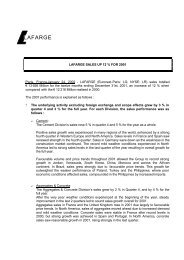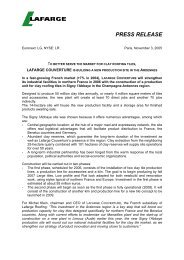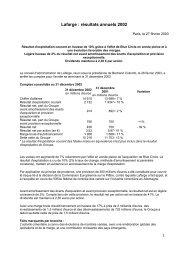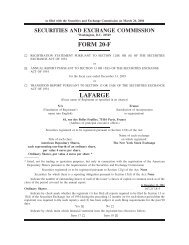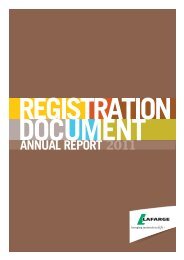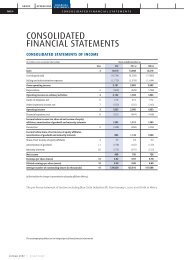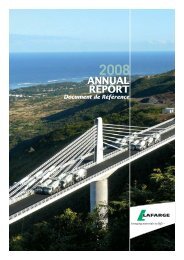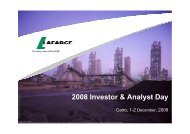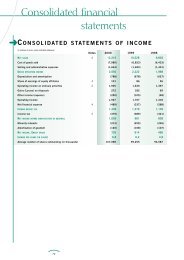Brochure: Lafarge, Leader in a Sustainable World
Brochure: Lafarge, Leader in a Sustainable World
Brochure: Lafarge, Leader in a Sustainable World
Create successful ePaper yourself
Turn your PDF publications into a flip-book with our unique Google optimized e-Paper software.
A high level of expertise<br />
Founded <strong>in</strong> 1833, <strong>Lafarge</strong> has built up cutt<strong>in</strong>g-edge<br />
expertise <strong>in</strong> the cement production bus<strong>in</strong>ess.<br />
Its unique knowledge of the production process<br />
is used throughout the world, thanks to the<br />
deployment of common tools that encourage<br />
knowledge-shar<strong>in</strong>g and performance analysis.<br />
All these assets improve plant reliability, help control<br />
ma<strong>in</strong>tenance costs and reduce energy consumption.<br />
Cement plant, Teil, France (top).<br />
Cement plant, Cairo, Egypt (bottom).<br />
Various uses<br />
The Cement Bus<strong>in</strong>ess L<strong>in</strong>e produces ranges of<br />
cements, hydraulic b<strong>in</strong>ders and lime for construction<br />
and renovation. Cement is also one<br />
of the ma<strong>in</strong> <strong>in</strong>gredients of concrete. Cement<br />
production is <strong>Lafarge</strong>’s longest-stand<strong>in</strong>g field<br />
of activity. The Group’s policy has long been<br />
to <strong>in</strong>crease its cement production capacities,<br />
particularly <strong>in</strong> emerg<strong>in</strong>g countries. Developments<br />
over recent years to improve performance<br />
have thus enabled the Group to construct<br />
plants more quickly and professionally.<br />
PAGE 08 | LAFARGE<br />
Cement: a universal,<br />
modern material<br />
50,000 employees<br />
and 166 production<br />
sites across<br />
50 countries.<br />
Essential <strong>in</strong> construction, cement is part of everyday life. <strong>Lafarge</strong>, number one<br />
worldwide <strong>in</strong> cement, is develop<strong>in</strong>g its production capacities while respect<strong>in</strong>g<br />
the environment and local communities.<br />
A comb<strong>in</strong>ed effort<br />
A cement plant requires a high level of <strong>in</strong>tegration<br />
<strong>in</strong>to the local social and economic climate.<br />
Install<strong>in</strong>g a plant <strong>in</strong>volves an average <strong>in</strong>vestment<br />
of €150 million and the plant itself will<br />
be active for decades to come.<br />
For <strong>Lafarge</strong>, the success of this <strong>in</strong>stallation is<br />
dependent on listen<strong>in</strong>g to all the stakeholders:<br />
the local authorities, associations, residents,<br />
entrepreneurs and local craftsmen. A socially<br />
and environmentally responsible approach,<br />
<strong>in</strong>volv<strong>in</strong>g dialogue and consultation with local<br />
AT THE ORIGIN<br />
communities, goes hand <strong>in</strong> hand with the <strong>in</strong>stallation<br />
and use of production sites. To guarantee<br />
susta<strong>in</strong>able development, <strong>Lafarge</strong> implements<br />
environmental good practices, such as the use<br />
of alternative fuels, which reduces the volume<br />
of CO2 emissions.<br />
Breakwater built to protect the<br />
Hassan II Mosque, <strong>in</strong> Casablanca, Morocco.<br />
Cement<br />
Derived from the Lat<strong>in</strong> cæmentum, mean<strong>in</strong>g “unhewn stone”. Used <strong>in</strong> masonry,<br />
it is also an essential <strong>in</strong>gredient of concrete.<br />
HIGH TEMPERATURE<br />
Cement manufactur<strong>in</strong>g<br />
requires the raw material<br />
to be heated to almost<br />
1,500 °C.<br />
Physicochemical<br />
transformation and CO2<br />
emissions<br />
Although the first<br />
cement was produced<br />
dur<strong>in</strong>g Antiquity,<br />
the current material is<br />
the result of a highly<br />
sophisticated <strong>in</strong>dustrial<br />
process. Today’s cement<br />
was discovered <strong>in</strong><br />
the 19th century and<br />
is made up of four<br />
components: limestone,<br />
silica, alum<strong>in</strong>a and<br />
iron oxide. The mixture<br />
is heated to a very<br />
high temperature<br />
(1,450 °C) to br<strong>in</strong>g<br />
about a physicochemical<br />
reaction known<br />
as “cl<strong>in</strong>kerization”. It is<br />
this process that is at<br />
the orig<strong>in</strong> of most of the<br />
CO2 emissions released<br />
by cement production.<br />
LAFARGE | PAGE 09




